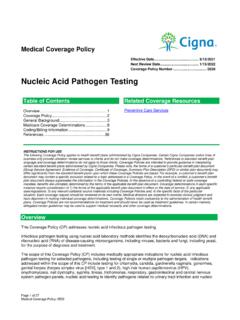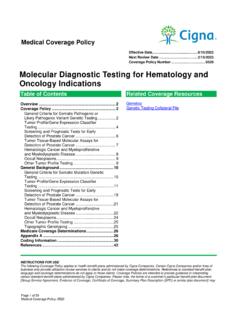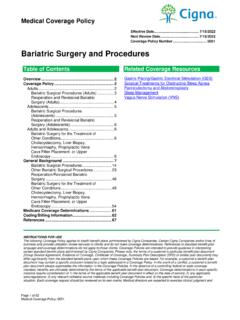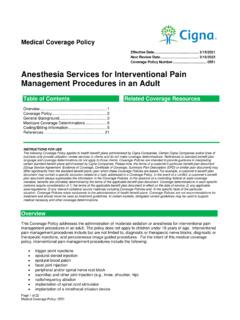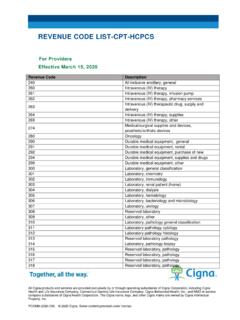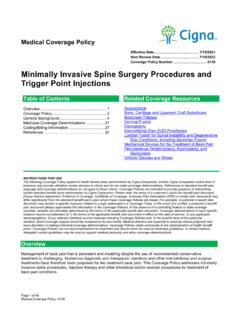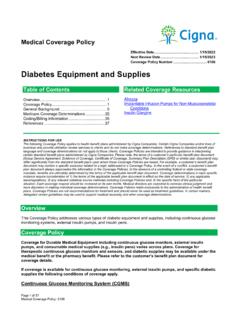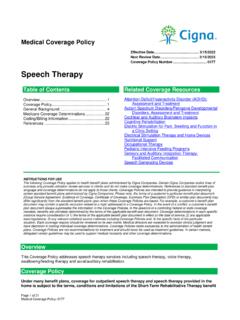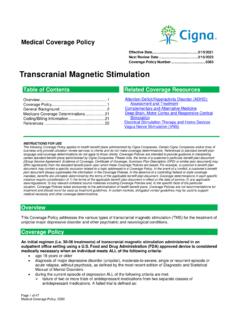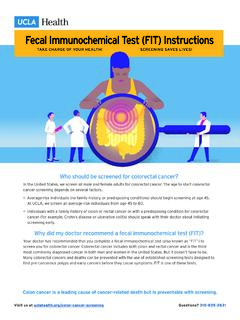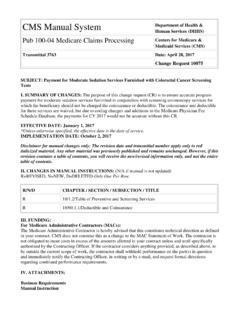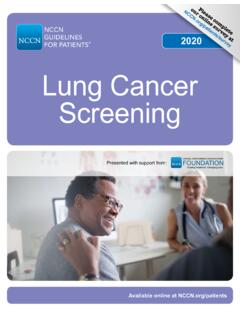Transcription of Colorectal Cancer Screening and Surveillance
1 Page 1 of 42 Medical Coverage Policy: 0148 Medical Coverage Policy Effective Date ..10/15/2021 Next Review Date ..10/15/2022 Coverage Policy Number .. 0148 Colorectal Cancer Screening and Surveillance Table of Contents Overview .. 1 Coverage Policy .. 1 General Background .. 2 Medicare Coverage Determinations .. 32 Coding/Billing Information .. 32 References .. 34 Related Coverage Resources Genetic Testing for Hereditary Cancer Susceptibility Syndromes Preventive Care Services Tumor Profiling, Gene Expression Assays, and Molecular Diagnostic Testing for Hematology/Oncology Indications INSTRUCTIONS FOR USE The following Coverage Policy applies to health benefit plans administered by Cigna Companies.
2 Certain Cigna Companies and/or lines of business only provide utilization review services to clients and do not make coverage determinations. References to standard benefit plan language and coverage determinations do not apply to those clients. Coverage Policies are intended to provide guidance in interpreting certain standard benefit plans administered by Cigna Companies. Please note, the terms of a customer s particular benefit plan document [Group Service Agreement, Evidence of Coverage, Certificate of Coverage, Summary Plan Description (SPD) or similar plan document] may differ significantly from the standard benefit plans upon which these Coverage Policies are based.
3 For example, a customer s benefit plan document may contain a specific exclusion related to a topic addressed in a Coverage Policy. In the event of a conflict, a customer s benefit plan document always supersedes the information in the Coverage Policies. In the absence of a controlling federal or state coverage mandate, benefits are ultimately determined by the terms of the applicable benefit plan document. Coverage determinations in each specific instance require consideration of 1) the terms of the applicable benefit plan document in effect on the date of service; 2) any applicable laws/regulations; 3) any relevant collateral source materials including Coverage Policies and; 4) the specific facts of the particular situation.
4 Each coverage request should be reviewed on its own merits. Medical directors are expected to exercise clinical judgment and have discretion in making individual coverage determinations. Coverage Policies relate exclusively to the administration of health benefit plans. Coverage Policies are not recommendations for treatment and should never be used as treatment guidelines. In certain markets, delegated vendor guidelines may be used to support medical necessity and other coverage determinations. Overview This Coverage Policy addresses Screening and Surveillance testing regimens for Colorectal Cancer .
5 Coverage Policy In certain markets, delegated vendor guidelines may be used to support medical necessity and other coverage determinations. For an average-risk individual age 45 years and older, the following Colorectal Cancer (CRC) Screening testing regimens are considered medically necessary: annual fecal occult blood test (FOBT) or fecal immunochemical test (FIT) flexible sigmoidoscopy every five years double-contrast barium enema (DCBE) every five years colonoscopy every 10 years computed tomographic colonography (CTC)/virtual colonoscopy every five years Page 2 of 42 Medical Coverage Policy.
6 0148 stool-based deoxyribonucleic acid (DNA) ( , Cologuard) testing every one to three years For an increased- or high-risk individual who fits into any of the categories listed below, more intensive Colorectal Cancer Screening , Surveillance or monitoring are considered medically necessary: personal history of adenoma or adenomatous polyps found on colonoscopy familial history of adenoma or adenomatous polyp found at colonoscopy in a first-degree relative personal or family history of Colorectal Cancer personal history of inflammatory bowel disease ( , ulcerative colitis, Crohn s disease) personal or inherited risk of a Colorectal Cancer ( , familial adenomatous polyposis [FAP], attenuated FAP, hereditary nonpolyposis Colorectal Cancer [HNPCC], MYH polyposis)
7 Chromoendoscopy is considered medically necessary for Colorectal Cancer Surveillance for patients at increased risk based on personal history of inflammatory bowel disease (IBD). The following are considered experimental, investigational, or unproven for any indication including, but not limited to, the Screening , diagnosis or Surveillance of Colorectal Cancer : fiberoptic polyp analysis, narrow band imaging, and confocal fluorescent endomicroscopy) chromoendoscopy for any other indication urine-based test for detection of adenomatous polyps ( , PolypDX) General Background Colorectal Cancer (CRC) is the third most common malignant neoplasm worldwide and the third leading cause of Cancer deaths in men and women combined in the United States.
8 (National Cancer Institute [NCI], 2021b) It is estimated that there will be 149,500 new cases diagnosed in the United States in 2021 and 52,980 deaths due to this disease. Between 2013 and 2017, incidence rates for CRC in the United States declined by about 1% per year and for the past 20 years, the mortality rate has been declining in both men and women (NCI, 2021b; American Cancer Society [ACS]c, 2021). Black adults have the highest incidence of and mortality from Colorectal Cancer compared with other races/ethnicities. From 2013 to 2017, incidence rates for Colorectal Cancer were cases per 100,000 Black adults, cases per 100,000 American Indian/Alaska Native adults, cases per 100,000 White adults, cases per 100,000 Hispanic/Latino adults, and cases per 100,000 Asian/Pacific Islander adults.
9 Colorectal Cancer death rates in 2014 to 2018 were deaths per 100,000 Black adults, deaths per 100,000 American Indian/Alaska Native adults, deaths per 100,000 non-Hispanic White adults, deaths per 100,000 Hispanic/Latino adults, and deaths per 100,000 Asian/Pacific Islander adults ( Preventive Services Task Force [USPSTF], 2021). The causes for these health disparities are complex; recent evidence points to inequities in the access to and utilization and quality of Colorectal Cancer Screening and treatment as the primary driver for this health disparity rather than genetic differences.
10 The recent trend for increasing Colorectal Cancer incidence in adults younger than 50 years has been observed in White and Hispanic/Latino adults but not Black or Asian/Pacific Islander adults. However, despite these trends, Black adults across all age groups, including those younger than 50 years, continue to have a higher incidence of and mortality from Colorectal Cancer than White adults (USPSTF, 2021). The etiology of CRC is heterogeneous and may be influenced by both the environment and genetics. There are groups with a higher incidence of CRC.
